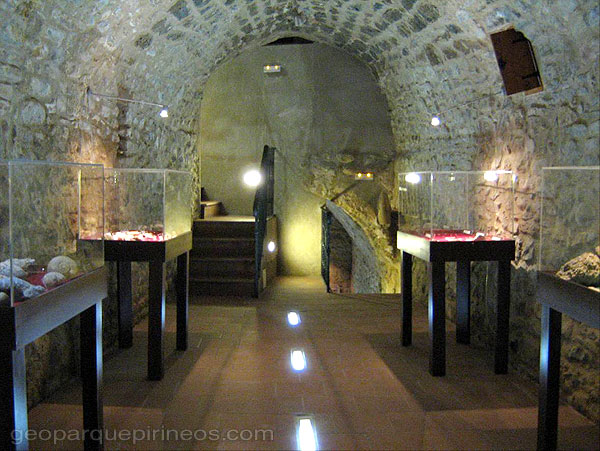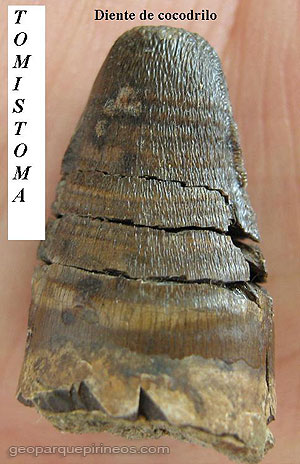Discover the Sobrarbe-Pirineos Geopark
- Visitor centre
- The Geopark Map
- Geology walking trails
- Roadside Geological route
- Geological routes on muntain bike
- Geo-mining Trail
- The Sorrosal Cascade
- Geoconservation , everyone´s responsibility
- Megalithic Routes of the Geopark
- Patrimonio Mundial
- Ordesa-Viñamala Biosphere Reserve
- Didactic resources
- Areas of geological interest
- Sobrarbe Museum of Paleontology
- Locally sourced Sobrarbe produce
- Friends of the Geopark
Sobrarbe Museum of Paleontology
Thanks to the effort and determination of private initiatives supported by the Geopark, a unique museum has been opened in Sobrarbe.
The museum is located in Lamata, within the municipality of Abizanda, in a building of 140 m2. Its main goal, besides showing our heritage to the non-professional public, is to carry on with our research in the areas of palaeontology and archaeology, offering our collaboration to universities and scientific institutions.

Fossil Museum in Lamata (Municipality of Abizanda). Image by J. Cardiel..
How to get to the Museum
From the A-138 that runs between El Grado, Aínsa and Bielsa, approaching from the south, just before the Ligüerre Inn, a small road heading westwards takes us to Lamata. The museum is located 50m away from its main square..
Visits
The museum can be visited by appointment..
- Manager: Jesús Cardiel Lalueza
- Tel: (00 34) 649 683 498
- E-mail: HYPERLINK "mailto:museolamata@yahoo.es" museolamata@yahoo.es
- Admission fee: 2 €. Special fees for groups.
Further information at http://fosilesdesobrarbe.blogspot.com

Inside the Fossil Museum in Lamata. Image by J. Cardiel.
Museum Themes
Almost every fossil exhibited in this museum dates from the Eocene epoch. From the Eocene in Old Sobrarbe, we can observe the gradation of the Sobrarbe Delta, the blue-greyish marlstones between Mondot and Erípol or near the Ligüerre Inn and Arcusa represent the delta front, that is to say, the part of the delta which was permanently submerged and affected by marine processes.
Above those marlstones, we find deposits which tell us about the deltaic front and the processes it suffered, such as tides or waves, as we can observe near Mondot and La Pardina among other places. Finally, we find the strata formed in the deltaic plain, where fluvial processes prevailed, as we can observe on the right bank of the Susía River.
Reddish colours are frequent in continental strata; paleosols are also typical, where we can find bioturbation. In those soils, we find an alternation of brown-reddish clays, sandstones and conglomerates, in deposits of one meter thick. Clays clearly prevail. This formation is known as the Escanilla Formation.
Strata experienced a huge lateral variation in thickness and composition and we can clearly observe ancient fluvial channels. Clays are formed by the deposit of materials in the channels, as a consequence of torrents and flows caused by heavy rainfalls.
The Continental Eocene is located in the southernmost area: Bárcabo, Hospitaled, Olsón, Lamata, and westwards from Escanilla. Near Olsón, we find the best place to study this formation. Lacustrine limestone and some of their structures stand out.
If anything is worth mentioning in the Sobrarbe Delta, it is its fossils. Some of them are unique and are of special scientific interest.

Lamata Crocodile Jaw. (Image by Jesús Cardiel).
Vertebrates
The most special fossils are exhibited, some of them are unique: Lamata crocodile, Abizanda femur, tortoises, mammals' teeth and jaws, etc There are six display cabinets dedicated to vertebrates..

Marine Crocodile tooth, similar to Tomistoma. Image by J. Cardiel.
Invertebrates and plants
We find a large variety of invertebrate fossils. They have been arranged by groups in 11 display cabinets. Plants are scarce, so they are exhibited in one single display cabinet, but they are samples of great scientific interest..

Sea urchin fossil (Eoscutum, Lambert & Thiery 1914), disk-shaped with a subconic profile. It dwelt in sandy coastal environments with rough waters. Image by J. Cardiel.

Dome-shaped coral colony fossil. Found in the rocks from Sobrarbe Eocene. Image by J. Cardiel.
Archaeology
In two display cabinets stone tools, pottery and metal tools found in Sobrarbe are exhibited, dating from different periods, from the Palaeolithic to the Modern Age. We can observe the development of stone tools and pottery..

Archaeological excavation in "Los Yermos del Cementerio". Image by J. Cardiel..
Avda. Ordesa 79. 22340 Boltaña. Huesca. 974 518 025. geoparque@geoparquepirineos.com
